People with a diagnosis of diabetes have a risk of complicating the disease - a diabetic foot.
A number of pathological processes trigger the mechanism of formation of wounds, ulcers and necrosis of tissues.
Contents
- 1 Symptoms of diabetic foot, photo
- 2 Diagnostic methods
- 3 Treatment of diabetic foot
Symptoms of diabetic foot, photo
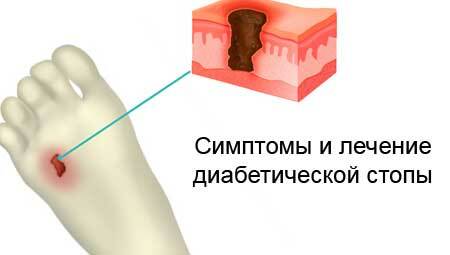
Diabetes causes destruction of vessels, skin and layers below them. The thumbs and toes under the fingers are most vulnerable.
With the development of the diabetic foot syndrome, the outflow of blood from the lower extremities is disturbed, stagnation of the fluid leads to the formation of wet ulcers.
Irritation, redness, and unpleasant odor from one or both legs common early symptom.
An indication of a serious foot ulcer is a black tissue( scab) surrounding the ulcer. It is formed due to the lack of a normal blood flow.
Partial or complete gangrene occurs due to tissue death due to infection. Appear fragrant discharge, a person can feel pain.
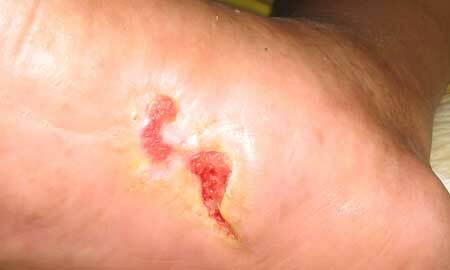
Appearance of ulcers, photo 2

Symptomatic progression, photo 3
Ulcer is not always obvious, sometimes symptoms are absent. It can develop subcutaneously, as evidenced by a discoloration of the skin. Sometimes this black spot, a little painful when pressing on adjacent tissue.
Symptoms accompanying diabetic foot syndrome:
- dry skin of feet and feet;
- temperature change of leg sections;
- swelling;
- flat feet;
- pain in the legs during movement and rest;
- subcutaneous hemorrhage;
- cyanosis of tissues;
- ulcers and suppurating wounds.
You can not hesitate to visit a doctor. Upon examination, he will determine the severity of the pathological process. To do this, there is an evaluation scale using objective criteria:
0 - no ulcers are detected, but the limb is in potential danger.
1 - ulcers are present, there are no signs of infection.
2 - the ulcer is deep, exposing the tendons and joints.
3 - the ulcer is extensive, the formation of abscesses from infection.
4 - gangrenous tissue change.
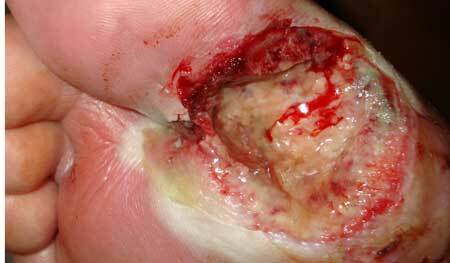
Severe condition, photo 4
Gangrene with diabetic foot is the most serious complication. The process of tissue death leads to severe disorders in the circulation and the attachment of anaerobic infection. The complication develops rapidly, it is irreversible.
In the absence of medical care, a person dies of blood poisoning. Treatment is radical - limb amputation.
Antibacterial therapy is carried out, the body is cleansed of toxins. Regular monitoring of the condition of the feet and feet prevents the development of gangrene.
Diagnostic methods
A doctor at the reception examines the patient's medical history and conducts an examination. He will be interested in:
- intensity of pain, its duration;
- when the first changes in the structure of the foot( deformation) occurred;
- concomitant diseases and complications of diabetes.
Visual examination assesses the color of the feet, probes the pulse and investigates the sensitivity.
Laboratory diagnostic methods:
- blood delivery for determination of glucose level;
- analysis of glycosylated hemoglobin;
- blood coagulation analysis;
- content of cholesterol in the blood.
The patient determines the sensitivity of the feet to temperature and vibration. On ultrasound( dopplerography) check the condition of the vessels, evaluate blood flow and pressure in the arteries of the lower extremities.
Duplex scanning determines the location of arterial narrowing. Blood supply of tissues is checked by transcutaneous oximetry. Informative X-ray images of bones and joints.
When trophic ulcers are sowing on the microflora of the contents of the wound, simultaneously investigate the sensitivity to antibiotics.
Treatment of diabetic foot
You can get qualified help from a surgeon or an endocrinologist in either specialist diabetes care centers( Diabetic Foot Center) or in a polyclinic.
The earlier the patient notices changes in the feet, the more favorable the prognosis of the treatment of the disease.
For all forms of diabetic foot, it is recommended to relieve the limb, reduce the load and pressure on the affected tissue. Otherwise, the infectious lesion will expand. For patients who are overweight, pressure on the foot causes permanent pain.
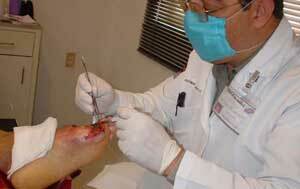
Surgical treatment, photo 5
When deforming the foot, the patient is recommended to wear special insoles, comfortable shoes. According to the indications, an operation is performed on the vessels to improve the blood supply of the lower extremities.
Complex treatment of diabetic foot consists of:
- sanation of ulcerative formations on the skin of the feet;
- reduced load on the limb;
- course of antibiotic therapy;
- control of blood sugar;
- quitting.
The doctor removes dead tissue and skin from an ulcer. Infection is a serious complication of foot damage and requires immediate treatment. Not all infections are treated equally. The tissues surrounding the ulcer are sent to the laboratory for the selection of a suitable antibiotic.
Patient needs to clarify how to properly care for his legs to prevent infection of the ulcer:
- foot bath;
- disinfects the skin around the ulcer;
- frequent change of dressings to keep the wound dry;
- sterility of the dressing.
The physician will prescribe antibiotics, antiplatelet or anti-coagulant drugs to treat diabetic foot ulcers if the infection progresses.
Antimicrobials are used to treat wounds( Chlorhexidine, Dioxydin, etc.).Lubricate the wounds and damage after disinfection, for this gel is suitable Solcoseryl, Actovegil, etc.
With a diabetic foot, iodine and zelenka can not be used - they burn tissue and prevent healing.
The wound is treated by a nurse or doctor, the dead particles are removed and washed. Therapeutic treatment procedures allow you to dispense with surgery if an ulcer is detected at an early stage. It is important to ensure the unloading of the limb at this stage.
Great importance is attached to the shoes worn by the patient. Recommended rest and limited limb in the vertical position. To do this, use special immobilizing bandages on the foot and shin.
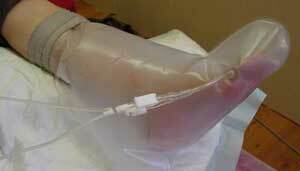
Ozonotherapy, photo 7
If the process takes a serious course and observes severe tissue damage, then the application of the dressing is excluded. Orthopedic footwear serves only as a preventive measure.
The danger of the formation of trophic ulcers exists continuously, if the level of glucose in the blood rises. In this case, wound healing on the skin of the feet worsens. Selective therapy to control the level of sugar facilitates monitoring and reduces the likelihood of developing a diabetic foot.
It is necessary to convince the patient of the rejection of bad habits. Alcohol and smoking increases the risk of atherosclerosis and alcoholic neuropathy. In addition, the stability of glucose in the blood is impaired.
Next:
- Signs of the initial stage of diabetic foot, photo
- Prevention and proper choice of shoes



